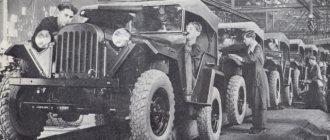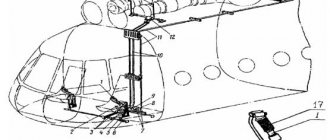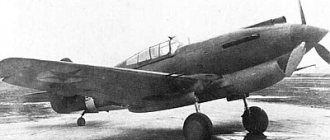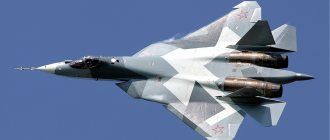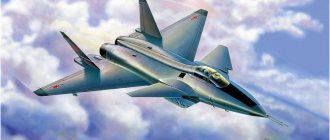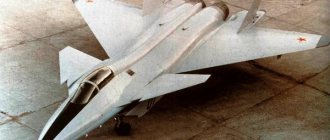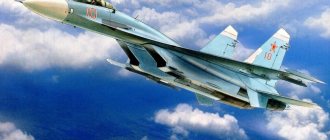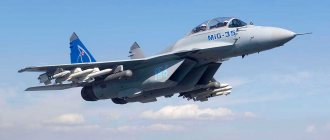Sukhoi Su-24, Bomber
In 1972, a new front-line bomber with variable wing geometry was adopted into service with the USSR Air Force. The vehicle, developed at the Sukhoi Design Bureau, received the index SU-24. In the West it became known as the “Bomb Truck.” The SU-24 is designed to carry out missile and bomb strikes in simple and difficult weather conditions, day and night, including at low altitudes with targeted destruction of ground and surface targets in manual and automatic control modes. The SU-24 used special equipment that allows it to fly while bending the terrain at an altitude of 200 meters at a speed of 1320 km/h. The possibility of such a flight significantly increased the survivability of the aircraft in combat. The SU-24 is equipped with an in-flight refueling system. The aircraft is built according to the classical design, and is a high-wing aircraft with a variable geometry wing. The aircraft wing has powerful mechanization, including slats, retractable double-slit flaps and spoilers. The aircraft's landing gear is three-post with dual-slope wheels. The design of the landing gear allows the aircraft to be used both from concrete airfields and from unpaved strips. Unlike most aircraft, the SU-24 uses a cockpit with transverse pilot placement. Placing pilots “shoulder to shoulder” made it possible to significantly reduce fatigue during a long flight and improve interaction. The cabin is equipped with class 0-0 ejection seats.
The SU-24 is equipped with modern electronic equipment, including a powerful digital computer. The aircraft has electronic warfare equipment, consisting of an electronic warfare station, a chaff ejection system and heat traps. The SU-24 has 8 weapons hardpoints (4 wing and 4 ventral). The two outer wing hardpoints, regardless of the wing sweep angle, are constantly located parallel to the fuselage. The SU-24 has a built-in 30mm or 23mm cannon (depending on modification) located on the left air intake. Double-beam holders can be installed on the suspension units under the center section. To reduce the mileage, the SU-24 is equipped with a braking parachute. Since 1985, the SU-24MK modification, which has new on-board electronic equipment and an in-flight refueling system, began to enter service. At the end of the 80s, a new modification of the aircraft was created in the tactical reconnaissance version. The aircraft received the designation SU-24MR. The SU-24MR provides all-weather integrated aerial reconnaissance day and night in a wide range of altitudes and speeds to a depth of up to 400 km behind the line of combat contact of troops. The aircraft is equipped with the BKR-1 airborne reconnaissance system. It consists of infrared, radar, television, laser, general radio and radiation reconnaissance equipment. In addition, the aircraft is equipped with equipment for panoramic and perspective photography. Control of reconnaissance assets is carried out both manually and automatically. The onboard navigation system ensures flight along a programmed route, bringing the aircraft to a reconnaissance area, and low-altitude flight following the terrain. In the nose of the aircraft there is a side-view radar “BANYET”, in the lower part there is an AP-402M panoramic aerial camera, in the lower part of the fuselage, immediately behind the cockpit there is a promising AFA-A-100, in the lower central part of the fuselage there is an IR viewing system. A container with SHPILE-M laser equipment is suspended on the central ventral unit, and a container with EFIR-1M radiation reconnaissance equipment is suspended on the right outer underwing unit.
The SU-24MR has no analogues among foreign front-line reconnaissance aircraft in terms of the complexity of the information received. For example, in the US Air Force, the RF-4C aircraft, which forms the basis of tactical reconnaissance aircraft, is not equipped with laser and radiation reconnaissance capabilities. On the SU-24MR, the collected photo information is processed directly on board and can be transmitted to the ground using special devices. The rest of the intelligence information is quickly transmitted via radio channels. The SU-24 was supplied to Iraq and a number of other countries. The Russian Air Force has about 800 SU-24s of various modifications, of which 35 are in the Navy aviation.
Su-24 – Basic modification. Su-24M - Modernized bomber, first flight - 1976. A new sighting and navigation system PNS-24M “Tiger” was installed. Capable of automatic and semi-automatic flight, skirting terrain at an altitude of 50 m. 770 units were produced. Su-24M2 - Second modernization of the bomber (1999). Su-24MK - Export version of the Su-24M, first flight - 1987. Su-24MP (item 46) – Jammer, first flight in December 1979. 10 aircraft were produced. Two aircraft were transferred to the Lipetsk Center, 8 entered service with the 118th separate aviation regiment of electronic warfare aircraft in Chortkov, Ukrainian SSR. After the collapse of the USSR, the regiment was disbanded in 1994; there is no reliable information about the further fate of the aircraft. Su-24MR – reconnaissance aircraft, first flight in September 1980. 130 aircraft were produced.
| Modification | Su-24M |
| Wingspan, m | |
| maximum (69 degrees) | 17,64 |
| minimum (16 degrees) | 10,37 |
| Aircraft length, m | 24.59 |
| Aircraft height, m | 6.19 |
| at an angle of 69 degrees. | 51,02 |
| at an angle of 16 degrees. | 55,16 |
| Weight, kg | |
| empty plane | 22300 |
| normal takeoff | 33500 |
| maximum takeoff | 39700 |
| maximum landing | 28000 |
| Fuel, kg | |
| domestic fuel | 9800 |
| PTB | 6590 |
| engine's type | 2 TRDF NPO Saturn AL-21F-3A |
| Thrust, kN | |
| unforced | 2 x 76.49 |
| forced | 2 x 110.32 |
| Maximum speed, km/h | |
| on high | 1700 |
| at sea level | 1400 |
| Ferry range, km | |
| with one refueling | 4270 |
| with two PTB | 2850 |
| Combat radius, km | |
| without PTB | 390 |
| with PTB | 560 |
| Practical ceiling, m | 11000 |
| Max. operational overload | 6.5 |
| Crew, h | 2 |
| Weapons: | one built-in 23-mm GSh-6-23M cannon with 500 shells; Combat load – 8000 kg on 8 hardpoints; guided and adjustable air-to-surface weapons (missiles Kh-23, Kh-23M, Kh-28, Kh-25MR, Kh-25ML, Kh-29L, Kh-29T, Kh-31P, Kh-58U, Kh- 58E, X-59; aerial bombs KAB-500L, KAB-500KR, KAB-1500L); unguided weapons (air bombs FAB-100, FAB-250, FAB-500M62, FAB-500M54, ZB-500Sh, ZB-500GD, RBK-250, RBK-500, NURS S-5, S-8KO, S-13T, S -13OF, S-24B, S-25OF, S-25OFM); air-to-air guided missile weapons (up to 2 R-60 or R-60M missiles). Container systems of the KMGU type can be suspended at seven points, and SPPU-6 suspended gun mounts with a movable six-barreled gun 9A-620 or 9A-768 of 23 mm caliber with 400 rounds of ammunition each can be suspended at 3 points. |
Story
Speaking about the Su-24M2, one cannot fail to mention the Su-24, on the basis of which it is assembled. "T-6" ("Su-24") was launched into mass production in February 1976. The aircraft was produced at the aviation plant in Novosibirsk until 1993. This year, the production of all modifications was completed, the main feature of which is a variable sweep wing, which allows flights at both subsonic and supersonic speeds. It is noteworthy that the heavy missile carrier Tu-16 was also originally designed by the Sukhoi Design Bureau based on the T-4 model.
In this case, the wings (on the front consoles) can take 4 positions: takeoff and landing - 16 degrees; subsonic flights are carried out at 36 degrees; supersonic - 69 degrees. There is also a 45 degree position designed for better maneuverability in combat.
Armament
The armament of the Su-24M2 is based on the Puma sighting and navigation system. The radar on which it operates can identify even subtle objects on water or land. According to its indications, it is possible to hit targets with all free-falling bombs on board. In addition, there is a third-generation passive radar system "Filin-N", covering 6 operating ranges of enemy detection stations. Theoretically, according to its data, it was possible to hit such objects, but this was later abandoned.
Modernization
The modern cost of military aircraft has increased significantly, as a result of which it is necessary to reconsider the possibilities for improving older models. The Su-24M2-Hephaestus, which underwent modernization at the plant of the same name, turned out to be very successful. And most military pilots agree that they will go into a good fight only on planes that have been to this enterprise.
The capabilities of bombing an aircraft that visited Hephaestus with conventional bombs became comparable to the results of using the latest KABs (aircraft bombs).
Design
Like the prototype, the Su-24M2 has a cabin designed for two people. The PIC is on the left, the navigator sits on the right, dual controls. There is nothing remarkable in the canopy of the car; like other aircraft of a similar type, it smoothly merges into streamlined elements of the fuselage that cover all the control wiring.
Two engines are located on the sides of the body, pressed against it, thereby freeing the wings from additional weight. The landing gear layout is designed for three support points; they can be removed during flight. The front pillar folds backwards along the way, the rear ones vice versa. Two side supports are located almost under the fuselage, since, in addition to all control systems, there are main fuel tanks, radio electronics units and other equipment. The wings, in addition to their main purpose, are used for attaching pylons holding weapons. The brake flaps are also located here, which are also the front doors of the niches in which the side landing gear is hidden in flight. When landing, they deviate up to 62 degrees perpendicular to the direction of flight. The engines have a thrust of 7800 kg, with afterburner they produce up to 11500 each.
A distinctive feature of the Su-24M2 is the presence of large monolithic milled panels. Their use has significantly reduced the cost of production. At the same time, this reduces the number of joints in the pressurized parts of the cabin and fuel tanks, which in turn improves flight safety. Most of the design is based on titanium, magnesium, and aluminum alloys. Engine parts operating at high temperatures are made of stainless steel.
Plumage characteristics
Among the modifications one can name the Su-24M2. Let's consider its characteristics in detail, since almost all other described models have the same capabilities. And “M2” can also be called a prototype of any of them.
Due to the high power developed by the engines of a military aircraft, the Su received a pair of air intakes located in front of the engines, which received several changes during its life. As a result, we came to the simplest solution - the air flow adjustment is activated only during takeoff and landing. Control is carried out by the movements of the flaps.
The wing has three sections of flaps and four sections of slats. The flap area is approximately 10 square meters. meters, in later versions of the aircraft flaps two and three were combined, as a result of which these versions have 2 sections. Their extension angle reaches 35 degrees. The slats have an area of 3 square meters. meters and an extension angle of 27 degrees. In later versions they were reduced by one section. Since the aircraft has variable wing geometry, the pylons are equipped with a position synchronization system relative to the longitudinal axis of the machine.
The vertical tail area is 9 meters, the keel sweep angle is 55 degrees. In the upper part of the tail (under the cap) there is a radio antenna. During the life of the bomber, drogue parachutes were moved from the fuselage under the rudder.
